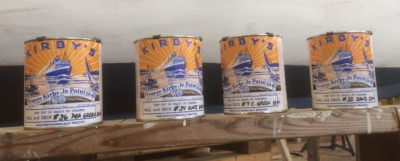MSR’s Alpine Chef’s Knife
For years, my favorite camp-cooking knife has been a Joyce Chen paring knife with a 3-3/4″ stainless blade and a plastic handle and sheath. It did most galley jobs well enough, but I can only get three fingers on the handle, the blade doesn’t extend far enough beneath the grip for cutting-board tasks, and the sheath, while dishwasher proof, has a slot that’s scarcely a millimeter wide and impossible to clean.

The sheath’s alternating openings make it easy to clean and dry its interior surfaces.
MSR’s Alpine Chef’s Knife has a 6-1/2″ blade with a modified Santoku shape, a Japanese style meant for mincing, dicing and slicing, the three uses suggested by the translation of santoku: “three virtues.” The plastic sheath solves the cleaning problem with alternating cutaways that allow all of the inner surfaces to be cleaned, while still providing full coverage for the cutting edge.
 Photographs by the author
Photographs by the authorThe stainless-steel blade holds a good edge and the offset handle is very well suited for chopping on a cutting board.
The stainless-steel blade takes and holds a sharp edge (you can see the knife slicing paper in the Small Boats video “Stropping” starting at 1:37) that can take neat millimeter-thick slices from a soft, ripe tomato. The drop point puts the whole edge close to a cutting board for chopping, while the offset plastic handle provides lots of clearance for knuckles.
The Alpine Chef’s Knife from MSR is priced at $16.95 and is available from REI, Back Country, Next Adventure, and Amazon.
Rheos Floating Sunglasses
With two pairs of my glasses hidden in the murky bottom of Lake Union and one pair in the cold depths of Puget Sound, I know that glasses sink. I was introduced to floating sunglasses years ago; if they go over the side, I have a good shot at recovering them. (I do have retaining straps to help prevent losing glasses, and wear them for rough-water passages when I have to focus on navigating, but I find them awkward when I’m frequently using cameras and binoculars.) My first pair has air chambers built into the temples. More recent versions are made of lightweight materials that are inherently buoyant.
For the past year I’ve been using two pairs of floating sunglasses from Rheos: first, the Eddies model, followed by the Reedy. They both have nylon lenses, polarized to reduce glare and coated for scratch resistance. The coating has worked well to protect the lenses and neither have visible scratches. The coating is hydrophobic—water will run off and any small beads of water that remain can be removed by tapping the frames. The lenses provide full UV protection.
 Photographs by the author
Photographs by the authorThere are subtle differences in the frames of the Reedy (left) and the Eddies (right). The temples of the Reedy are a bit more flexible than those of the Eddies and make contact with the wearer’s head at a gentler angle. The Reedy frame is the better match for large heads. The Eddies offer a tighter fit for average heads while remaining comfortable.
I opted for “gunmetal,” a neutral gray color, for the lenses of both glasses. They’re dark enough to tame the sunlight on a clear summer day but not so dark that the world grows dim under an overcast sky. The polarization has effectively cut the otherwise blinding glare when I’ve paddled straight into the sun late in an afternoon. The Eddies are described by Rheos as having a “tight-fitting wraparound frame,” and at first I thought that would serve to keep the glasses secure on my head, but after about a half-hour the pressure of the temple tips became uncomfortable. At the end of a 90-minute kayak outing, I was happy to take the glasses off. I have a large head—hat size 7-5/8—and those with smaller sizes are not as likely to find the pressure objectionable.

Both of the Rheos models are light enough to float.
Rheos sent out the Reedy model, which is described on their website as having “a medium to large wrap-around frame.” The temple tips have a different shape to better distribute the pressure, and the temples are more flexible. The Reedys are very comfortable even for all-day use and still secure enough that they don’t slip down my nose. At 0.9 oz, they’re even lighter than the 1-oz Eddies.

The Reedy sunglasses came with an ingenious case that forms a rigid, protective prism shape for the glasses, and folds flat when not in use. A magnetic catch holds the case closed.
The Reedy sunglasses do their job, and do it well, by slipping from my consciousness: I cease to be bothered by the sun, and I forget that I have sunglasses on.![]()
Christopher Cunningham is the editor of Small Boats Magazine.
The Reedy and the Eddies are available from Rheos for $78 and $55, respectively. The Eddies are also available on the Rheos Amazon store.
Is there a product that might be useful for boatbuilding, cruising, or shore-side camping that you’d like us to review? Please email your suggestions.












I need a pair after losing my sunglasess to the murky deep at the local ramp …now known to Skipper as the “Rayban Ramp.”